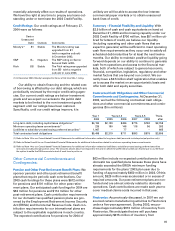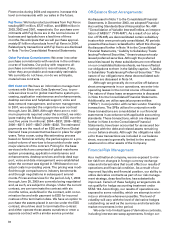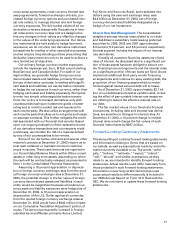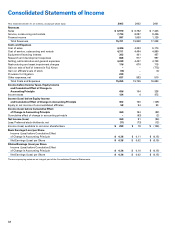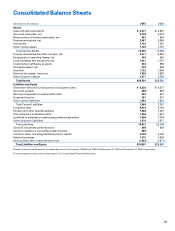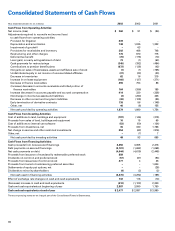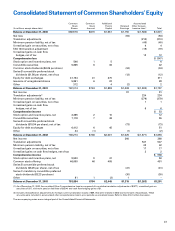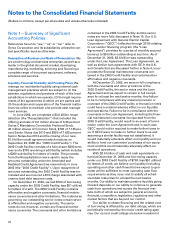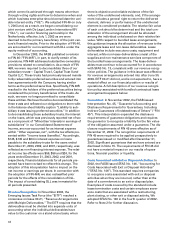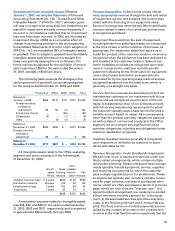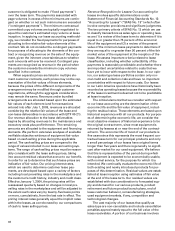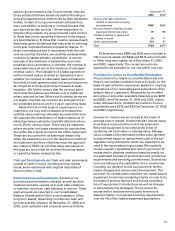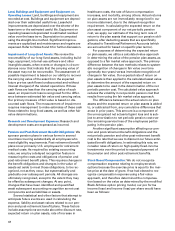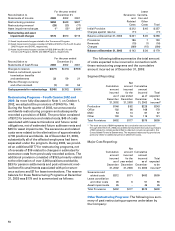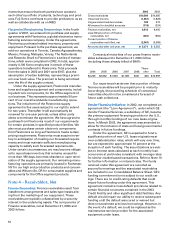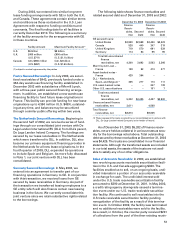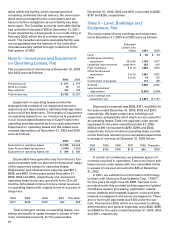Xerox 2003 Annual Report Download - page 47
Download and view the complete annual report
Please find page 47 of the 2003 Xerox annual report below. You can navigate through the pages in the report by either clicking on the pages listed below, or by using the keyword search tool below to find specific information within the annual report.
45
Goodwill and Other Intangible Assets: Effective
January 1, 2002, we adopted Statement of Financial
Accounting Standards No. 142, “Goodwill and Other
Intangible Assets” (“SFAS No. 142”), whereby good-
will was no longer to be amortized, but instead is to be
tested for impairment annually or more frequently if
an event or circumstance indicates that an impairment
loss may have been incurred. In 2002, we recorded an
impairment charge of $63 as a cumulative effect of
change in accounting principle in the accompanying
Consolidated Statements of Income. Upon adoption of
SFAS No. 142, we reclassified $61 of intangible assets
to goodwill. Prior to adoption, goodwill and identifiable
intangible assets were amortized on a straight-line
basis over periods ranging from 5 to 40 years. Pro
forma net loss as adjusted for the exclusion of amorti-
zation expense of $59 for the year ended December
31, 2001 was $35 or $0.06 per share.
The following table presents the changes in the
carrying amount of goodwill, by operating segment,
for the years ended December 31, 2003 and 2002:
Production Office DMO Other Total
Balance at
January 1, 2002 $605 $710 $ 70 $121 $1,506
Foreign currency
translation
adjustment 82 55 (3) – 134
Impairment charge – – (63) – (63)
Divestitures (4) – (1) – (5)
Other – (5) (3) – (8)
Balance at
December 31, 2002 $683 $760 $ – $121 $1,564
Foreign currency
translation
adjustment 88 67 – 3 158
Balance at
December 31, 2003 $771 $827 $ – $124 $1,722
All intangible assets relate to the Office operating
segment and were comprised of the following as
of December 31, 2003:
Accu-
Amorti- Gross mulated
zation Carrying Amorti- Net
Period Amount zation Amount
Installed customer base 17.5 years $209 $ 45 $164
Distribution network 25 years 123 20 103
Existing technology 7 years 103 56 47
Trademarks 7 years 23 12 11
$458 $133 $325
Amortization expense related to intangible assets
was $35, $36, and $40 for the years ended December
31, 2003, 2002 and 2001, respectively, and is expected
to approximate $36 annually through 2008.
Revenue Recognition: In the normal course of busi-
ness, we generate revenue through the sale and rental
of equipment, service and supplies and income asso-
ciated with the financing of our equipment sales.
Revenue is recognized when earned. More specifically,
revenue related to sales of our products and services
is recognized as follows:
Equipment: Revenues from the sale of equipment,
including those from sales-type leases, are recognized
at the time of sale or at the inception of the lease, as
appropriate. For equipment sales that require us to
install the product at the customer location, revenue is
recognized when the equipment has been delivered to
and installed at the customer location. Sales of cus-
tomer installable products are recognized upon ship-
ment or receipt by the customer according to the
customer’s shipping terms. Revenues from equipment
under other leases and similar arrangements are
accounted for by the operating lease method and are
recognized as earned over the lease term, which is
generally on a straight-line basis.
Service: Service revenues are derived primarily from
maintenance contracts on our equipment sold to cus-
tomers and are recognized over the term of the con-
tracts. A substantial portion of our products are sold
with full service maintenance agreements for which
the customer typically pays a base service fee plus a
variable amount based on usage. As a consequence,
other than the product warranty obligations associat-
ed with certain of our low end products in the Office
segment, we do not have any significant product
warranty obligations, including any obligations under
customer satisfaction programs.
Supplies: Supplies revenue generally is recognized
upon shipment or utilization by customer in accor-
dance with sales terms.
Revenue Recognition Under Bundled Arrangements:
We sell most of our products and services under bun-
dled contract arrangements, which contain multiple
deliverable elements. These contractual lease arrange-
ments typically include equipment, service, supplies
and financing components for which the customer
pays a single negotiated price for all elements. These
arrangements typically also include a variable compo-
nent for page volumes in excess of contractual mini-
mums, which are often expressed in terms of price per
page, which we refer to as the “cost per copy.” In a
typical bundled arrangement, our customer is quoted
a fixed minimum monthly payment for 1) the equip-
ment, 2) the associated services and other executory
costs, 3) the financing element and 4) frequently sup-
plies. The fixed minimum monthly payments are mul-
tiplied by the number of months in the contract term
to arrive at the total fixed minimum payments that the


